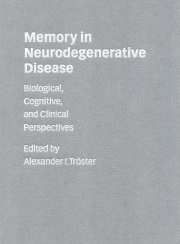Book contents
- Frontmatter
- Contents
- List of contributors
- Preface
- PART I Biological perspectives
- 1 Nonhuman primate models of memory dysfunction in neurodegenerative disease: contributions from comparative neuropsychology
- 2 Nonprimate animal models of motor and cognitive dysfunction associated with Huntington's disease
- 3 Neuropathology and memory dysfunction in neurodegenerative disease
- 4 Neurochemical aspects of memory dysfunction in neurodegenerative disease
- 5 Structural neuroimaging correlates of memory dysfunction in neurodegenerative disease
- 6 Functional neuroimaging correlates of memory dysfunction in neurodegenerative disease
- 7 The biology of neurodegenerative disease
- PART II Cognitive perspectives
- PART III Clinical perspectives
- Index
5 - Structural neuroimaging correlates of memory dysfunction in neurodegenerative disease
from PART I - Biological perspectives
Published online by Cambridge University Press: 23 November 2009
- Frontmatter
- Contents
- List of contributors
- Preface
- PART I Biological perspectives
- 1 Nonhuman primate models of memory dysfunction in neurodegenerative disease: contributions from comparative neuropsychology
- 2 Nonprimate animal models of motor and cognitive dysfunction associated with Huntington's disease
- 3 Neuropathology and memory dysfunction in neurodegenerative disease
- 4 Neurochemical aspects of memory dysfunction in neurodegenerative disease
- 5 Structural neuroimaging correlates of memory dysfunction in neurodegenerative disease
- 6 Functional neuroimaging correlates of memory dysfunction in neurodegenerative disease
- 7 The biology of neurodegenerative disease
- PART II Cognitive perspectives
- PART III Clinical perspectives
- Index
Summary
INTRODUCTION
The study of in vivo brain–behavior relationships has been significantly enhanced by advances in structural neuroimaging procedures. This chapter describes the recent contributions of these technologies to our understanding of brain–behavior correlations and, in particular, the relationships between brain structures subserving memory and the memory disorders characteristic of the different etiologies of dementia. These advances are largely the result of enhanced resolution of brain images, the use of careful statistical approaches to examine imaging data and the appreciation for the influence of demographic characteristics such as age, gender and head size when considering group results.
NEUROIMAGING ISSUES
Structural brain imaging technologies provide the opportunity to determine the condition of the brain in individuals who are also given tests of cognitive, sensory and motor functioning. Even with these techniques, however, structure–function studies are difficult because these technologies are complex and there are no established conventions for acquisition, processing, analysis or statistical interpretation of neuroimaging data.
Image quality is affected by the technology chosen and the interaction of acquisition parameters that determine resolution. Structure measurements are substantially influenced by boundary definitions, which can vary across neuroanatomy atlases and by correction factors applied to account for unwanted sources of variation, such as head size, sex and age. Before reviewing the literature on the contribution of structural imaging to our understanding of the neuropathological substrates of memory impairment in neurodegenerative diseases, this chapter provides a brief overview of some essential issues to bear in mind when critically reading studies using structural imaging methods (for reviews see Jernigan and Cermak 1994; Lim et al. 1995; Raz 1996).
- Type
- Chapter
- Information
- Memory in Neurodegenerative DiseaseBiological, Cognitive, and Clinical Perspectives, pp. 100 - 127Publisher: Cambridge University PressPrint publication year: 1998



